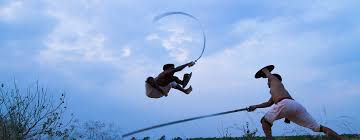South Asian Martial Arts: Angampora
- Amir Hamza
- Jul 8, 2020
- 4 min read
We did an article on African Martial Arts and now here is our own take on South Asians styles. As we know most martial arts media like fighting games tend to be over abundant with American, Chinese and Japanese characters using mostly East Asian styles, So what about other regions in the world? well for South Asia, we have Dhalsim.... that's kinda almost it. But we all know that media can do way more. We are only covering South Asian countries for this article which you can see what is officially Classified as South Asian by clicking the link.
Starting us off we have the South Asian Island nation of Sri Lanka where the martial art Angampora originates. This style mostly specialises in Strikes and Grabs but has more eclectic applications to it. It is also a stuff of myths and legends believed to be the fighting style of ancient Kings and giant warriors. So let's begin.

Martial art: Angampora
Style: Striking/Grappling
Country: Sri Lanka
Origin: The origin of the Sri Lankan martial art Angampora or Angam for short is unclear. The Sinhalese etymology of the name comes from Anga meaning body and pora meaning fight. The style is believed to be originated at least 3000 years ago by the Yaksha tribe. However other sources believe the style existed even longer at least 5000 years ago with mythical warriors such as King Rana Ravana and the 10 Giant Warriors being the mythological practitioners of the martial art. There also exists Elangam or Ilangam for weaponry focused training.
History: The earliest records of the style would possibly be the 10th century during the Anuradhapura Kingdom, which began the medieval period of Sri Lanka however many record of kings and warriors training was sketchy at best but known. During the 15th century there was the battle of Mulleriyawa where Angam became an invaluable asset to fend off invaders. However after the British conquered the island, the appointed governor of Ceylon Robert Brownrigg banned and outlawed the practice of Agam. Extreme measures were taken that included imprisonment, persecution, and an order to cripple by gunshot any known practitioner of the art.
In the outset of such times, many gurus masters of the art, along with its avid practitioners went underground, and employed various methods of concealing the art in plain sight. This almost mirror how the art of Capoeira had survived by disguising itself as a dance. The rhythmic movements of Sri Lankan Traditional dance, where hidden within the graceful bend of a knee or the flip of a hand was a deadly and effective technique of Angam.

Culture: As an empty handed fighting style Angampora specialise in three main disciplines. The first of these is Gattaputtu or Gattaharammba, this discipline Focuses one using joint locks, trapping, grabbing, disarming or physically countering and reversals are taught. Some of these can range from simple technique found in other styles or complicated locks and joint snapping holds. Pora Harammba (sometimes it is split into Pora and Gutti Harammba) focuses more on offensive and defensive strikes. There are allegedly 18 variations of striking and 7 specific blocks. Some schools have the striking and blocking technique categorised as part of Gutti Harammba whilst Pora Harammba is more centred on Takedowns, ground fighting and grappling. The final discipline of Agam, is called Maru Kala which specialises in pressure or nerve points. Much like Chinese Acupuncture or Indian Varma Kalai. This style exploits the nerves points of their opponents to disable their muscle, organ functions and possibly death if practiced right. However majority og Master will not teach this to their students unless they prove to be most trustworthy and are experienced students. They must also have high standard of qualities as a person. After extensive ceremonies offered to the god Rawana, and taking 7 oaths will the Gurus then consider passing on the knowledge.
Warrior: Warriors practicing the style typically wear similar clothing to Kalari warriors which usually include white baggy shorts or trousers for male and no shirts. Some modernise school allow vests or shirts to be worn especially since female practitioners would be required as such. Within the weaponry style of Ilangam typically Swords, shield, knives and Staves are used. But they also possess the Ethunu Kaduwa a sword whip which is identical to the Urumi seen in Indian Kalaripayattu. Another component but discarded is the Maya Angam which is the idea of using spells or incantations for combat. But this maybe have been a psychological practice in war when using Mara Kala to kill or paralyse enemies. Giving the impression of using magic to drive fear of the unknown was effective.

Media/Potential: In recent years there's been only few media coverage of the Angampora martial arts. In its native Sri Lanka, the talent show Sri Lanka's got talent featured the martial art in 2018 by a group called SL air force. There performance lead to the judge Dilshan to award them the golden buzzer. British Sri Lankan comedian Romesh Ranganathan hosted a documentary of himself where he tries to become more in touch with his Sri Lankan heritage. At one point his uncle decides to have him train in Angamporam which Romesh in typical comedic fashion fails to handle the training. While the film, TV and video game industry has yet to use Angampora in fiction. It is notable that Fighting Game Battle Arena Toshiden has the only few Sri Lankan character in a fighting game to date. Chaos is a knife wielding antagonist of the series, while his fighting style is never stated. Much like Kukri in King of Fighters he is portrayed as a generic professional Middle East Assassin. Despite his country of origin being Sri Lanka. If the series ever revives for a modern Battle Arena Toshiden game, Chaos could be revamped into a more accurate Angamporan fighter with a better name too hopefully.



Comments